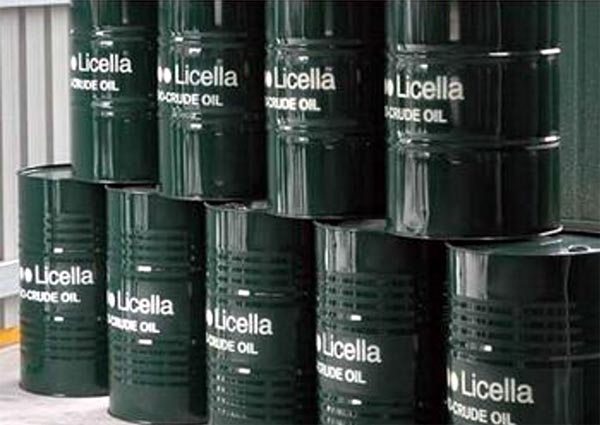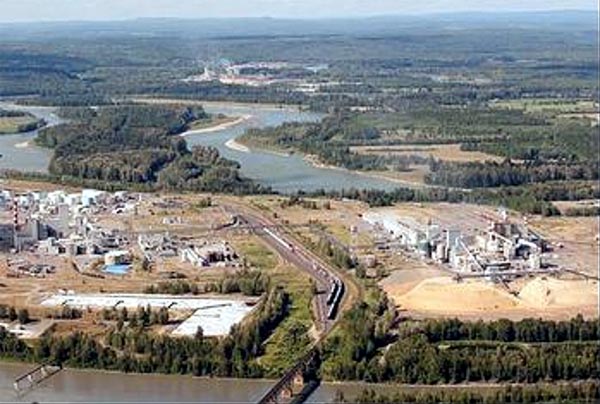CanFor Reports Interest in Kraft Pulp Waste to Biocrude Conversion
![]() Print this Article | Send to Colleague
Print this Article | Send to Colleague
Scientists with the Australian startup Licella reported this past week (June 22) they have successfully devised a way to use biomass waste from the kraft papermaking process to make a more refined and efficient form of energy for the industry, petroleum substitute – biocrude oil – that has now attracted the interest of Canadian P&P producer CanFor (Vancouver, B.C.).
The process can convert biomass, including wood residues from Canfor Pulp’s kraft pulping processes, into biocrude oil that is ready to go into existing petrochemical refinery streams to generate renewable fuels.
The ITQ laboratory in Valencia, Spain, has demonstrated that it is possible to upgrade Licella’s biocrude to kerosene and diesel utilizing standard refinery infrastructure.

Barrels of biocrude (pictured above) resulted from applying Licella’s Catalytic Hydrothermal Reactor technology to the waste left from Canfor’s pulp and papermaking.
Other biofuels are typically low-energy density, are not stable, and are difficult to transport and blend. Licella’s biofuel has proven to be stable, transportable, and blendable.
Canfor plans to invest funds sufficient to build commercial-scale biocrude plants that are integrated with adjoining pulp and paper plants to transform the resource-intensive pulp and paper industry.
Co-founded by University of Sydney chemistry professor Dr. Thomas Maschmeyer, Licella developed the unique process in partnership with the University of Sydney. Its Catalytic Hydrothermal Reactor (Cat-HTR™) technology converts low-cost, non-edible, waste biomass into biocrude oil.
"Only 30 % or so of a tree becomes paper, the rest is waste. We use this waste to make a new product – biocrude oil from renewable, already aggregated waste," Maschmeyer explained.
During the past nine years, Licella has invested A$60 million in its technology development.
"After nine years of very hard work by an amazing team of individuals at Licella and the university, it is extremely pleasing to see this Australian green technology going global; it will make a substantial impact," Maschmeyer said.
Licella CEO Dr. Len Humphreys said that "Licella’s Cat-HTR technology may add significant value to Canfor Pulp’s kraft process by creating new products from Canfor Pulp’s waste streams. What we are potentially building towards is a bio-refinery to utilize the entire tree, rather than part of the tree."
"Using the whole tree and not just a minor part will move the industry towards biorefining," said Humphreys.
Canfor President Brett Robinson said that the Cat-HTR technology is a good fit for his company. "The opportunity to directly produce advanced biofuels from our existing streams could transition Canfor Pulp from being strictly a pulp and paper manufacturer to a bio-energy producer as well," he said.

Pictured above: Canfor’s three pulp mills (clockwise from far top): the Northwood, Prince George, and Intercontinental mills.
Currently, pulp and paper waste is burned for low-quality process heat. But now Licella’s Cat-HTR technology can theoretically process any form of ligno-cellulosic biomass, without the need to dry the feedstock before processing.
Professor Maschmeyer said that "in the pulp and paper industry worth billions of dollars, this shift will have global impact for good."
Licella is a subsidiary of Licella Pty. Ltd., which in turn is a subsidiary of Ignite Energy Resources Ltd., an Australian public unlisted natural resource and energy technology development company.
In late May, Licella Fibre Fuels Pty Ltd. and the publicly-traded Canfor Pulp Products Inc. (CPPI) signed an agreement to form a joint venture under the name Licella Pulp Joint Venture.
The agreement follows a successful program of preliminary trials conducted on feedstock from Canfor Pulp’s Prince George, British Columbia pulp mill at Licella’s pilot plants located at Somersby, an hour north of Sydney in New South Wales, Australia.
In these trials, wood residue streams from Canfor Pulp’s kraft process were successfully converted into a stable biocrude oil.
"Biofuels and biochemicals represent the next frontier in the utilization of sustainable wood fiber to produce green energy and chemicals," said CPPI Chief Executive Don Kayne. "This initiative underscores Canfor Pulp’s commitment to innovation and the importance of green energy and chemicals in our future product mix, and we look forward to developing this potentially transforming technology with Licella," he said.
Upon successful integration of the Cat-HTR technology, the Licella Pulp joint venture will investigate offer this solution to other third party pulp mills.
Earlier this month, the 24th European Biomass Conference and Exhibition in Amsterdam provided a unique overview of the state of play of the sector and a much clearer view of the role biomass can play in achieving the transition to a low carbon economy.
After the landmark Paris Climate Agreement reached in December 2015, and signed by 175 nations in April, international institutions and scientific organizations agree that biomass and the bio-based economy are crucial to help the world meet the climate change target of less than two degrees Celsius temperature rise over pre-industrial levels.


